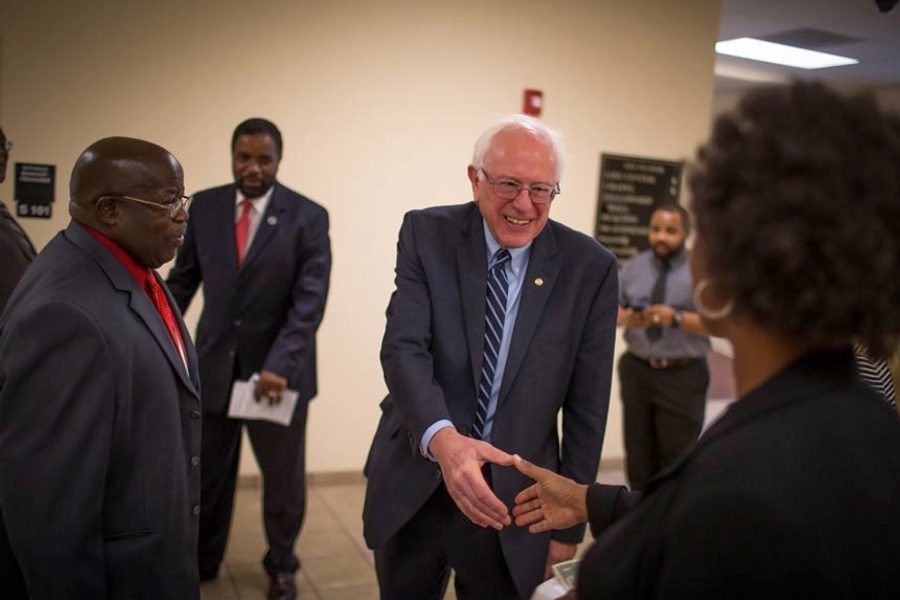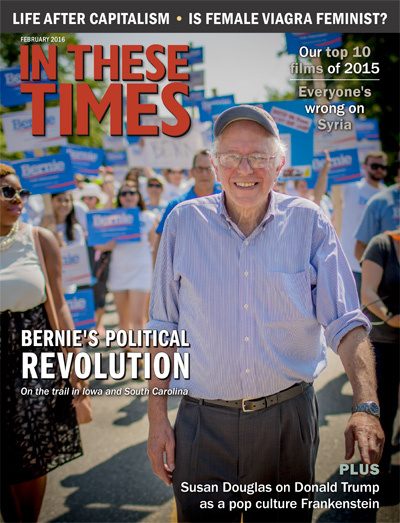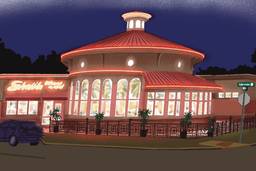How Bernie Sanders Could Actually Pull Off an Upset in South Carolina
Surprising numbers of South Carolinians like Bernie—if they’ve heard of him
David Moberg

Charleston, S.C.— Even without miracles, Sen. Bernie Sanders could be the next American president. But miracles would help. The Independent/Democrat/democratic socialist from Vermont, by way of Brooklyn, virtually tied former Secretary of State Hillary Clinton in Iowa and won handily in New Hampshire, the first two contests. Polls on average show Clinton ahead in the next two, Nevada’s caucus and the South Carolina primary, but few reflect how early votes may suggest that Sanders is more viable than many voters thought.
Clinton strategists are counting on her stopping any Sanders momentum by winning most of a “firewall” of Southern states, starting with South Carolina on February 27 and extending through six of the 11 contests on March 1, aka Super Tuesday.
Even Rand Wilson, a volunteer with the independent Labor for Bernie organization and a firm believer in Sanders’ chances, says, “If Bernie doesn’t break the firewall, it’s game over.”
A Sanders victory in South Carolina — or even a near-miss — would smash through the firewall and force the press and voters to pay more attention to him, undermining the self-fulfilling prophecy of Clinton’s inevitability. But South Carolina will be challenging terrain for this test. A Dec. 20, 2015, CBS poll showed Clinton with a 36 percent lead among likely primary voters in the state. The gap stretched even wider, to nearly 60 points, among African-American voters, who made up 55 percent of South Carolina’s Democratic primary turnout in 2008. Yet even before the Iowa caucuses, her lead over Sanders dropped to 30 percent in an average of two late January polls by NBC and CBS.
Conventional wisdom favors Clinton, but it sometimes proves not so wise. After all, Clinton was supposed to take South Carolina in 2008 and lost to a skinny young senator from Illinois with a funny name.
Sanders has a longer way to go in a shorter amount of time — by January 2008, Obama and Clinton were tied— although he can probably count on a last-minute burst of enthusiasm from South Carolina’s university students and young voters, as in other states. And momentum is on his side. He narrowed Clinton’s lead by around 15 points in the last two months of 2015. That’s where key Sanders supporters like Christale Spain and John Grimsley enter the fray.
Until last September, Spain, a 39-year-old African-American graduate of the University of South Carolina Aiken, was deputy executive director of the state Democratic Party. Then she joined the Sanders campaign, where she now serves as the political outreach director. Like so many of his supporters, she was drawn by “Bernie’s message, his platform, specifically racial justice,” such as reforms of policing and criminal-justice policies, which take on grave significance for her as the mother of a 15-year-old. But she also finds Sanders’ campaign appealing because it promotes policies that combine both racial and class justice, such as a $15 minimum wage, expanded social security, free tuition at public colleges and universities, and universal, singlepayer healthcare.
Grimsley, 48, is an electrician and a member of the International Brotherhood of Electrical Workers union. With only 2.1 percent of the workforce in South Carolina who are members of unions, he’s a rarity — a white, working-class union member in the South who is not afraid of Sanders’ “socialistic idea.” As Grimsley sees it, socialism is simply the reasonable notion “that we’re all in this together, and we tax the rich people to pay for it.” He played a video of Sanders’ message to his local union hall and convinced his fellow members, many of whom previously knew little about the candidate, to endorse Sanders with very little and low-key hesitation.
Respectively, Spain and Grimsley speak to two constituencies that are key to Sanders’ success but often at odds politically — black voters and white working-class voters. Sanders strategists believe that both groups would greatly benefit from the policies he advocates, but the campaign has not yet mobilized the overwhelming support of either. Whether Sanders can win in South Carolina rests in large part on whether he can break through to them.
Bernie who?
The biggest potential — and possibly biggest impediment — comes in Sanders’ effort to expand support from black Democratic voters. Based on the makeup of the 2008 electorate, Sanders may need more than 50 percent of the black primary vote to win South Carolina.
Judging from In These Times’ interviews with several dozen South Carolinians and from reports by organizers, many African Americans like Sanders’ concrete proposals and cheer his battle against the “billionaire class” that is ripping off the 99% through a “rigged economy.” But Sanders’ problem is how little he’s known among voters — especially black voters — according to organizers. “Our main goal is to educate people in the African-American community,” says Chris Covert, the campaign’s state director.
Hillary Clinton, for her part, has some big chits in the primary game: She is well known in South Carolina and benefits from residual affection for Bill Clinton among African-American voters, despite the harm done by his policies on welfare, mandatory sentencing, NAFTA and other issues. Pragmatism also works in her favor: Black voters lean strongly Democratic and have plenty of reason to worry about a Republican in the White House.
As I walked around a largely black, low-income neighborhood of North Charleston, the people I talked with were consistently pro-Clinton and admitted not knowing much about Sanders. But the commitment often seemed shallow. “I’d go with Hillary Clinton,” says a 63-year-old man who supports himself with Social Security disability payments, “because she’s going to be the damned president.”
A 36-year-old mother of four who planned to vote for Clinton says that “all I know is Ben Carson is saying things that are off the wall. …[Clinton’s] got my vote. The Republicans are worse than the Democrats. They want to cut all the programs [that help people like me].” When asked what she thought of Sanders’ support for a $15 minimum wage, she smiles broadly. “Now you’re talking,” she says. “Oh, I’d like that. I make $8 an hour cleaning rooms.”
“People have no idea of who he is,” says Christale Spain. “That’s the obstacle here in South Carolina. Once [they] spend 10 minutes finding out what he’s done, they’ve completely turned our way. Now we’re making inroads.”
Luckily for Sanders, Spain’s previous post in the Democratic Party taught her the political nitty-gritty that complements his focus on big ideas. And it helps Sanders to have a high-profile, local black organizer accompany him on his forays to promote those ideas in the black community’s barbershops, hair salons, churches and meeting halls, as well as producing ads for black community radio. Three jam-packed visits in late fall seem to have generated some energy for the campaign, converting mid-level black Democrats and boosting his poll numbers.
There are still more prickly problems. South Carolina’s Democratic establishment is fairly conservative. According to Adolph Reed, a University of Pennsylvania political scientist who works with both the Sanders and the Labor for Bernie campaigns, many local black politicians in South Carolina look to candidates like Clinton for future jobs, contracts and contacts, and often define civil rights in terms of their special interests. This political climate goes as far back as Bill Clinton’s 1992 campaign, he says: “Clinton people went through the region and had a powerful message. Our guy is going to get the nomination, and if you want access, get on board right now.”
South Carolina Democratic state Rep. Terry Alexander, a prominent African American minister and former Clinton supporter, is a high-profile convert to Sanders. “I like Sanders,” he says. “He’s very approachable, a good old country boy from up the road. [Clinton] is running more on her name than on what are the best policies. What’s she done for African Americans?” To people concerned about Sanders’ socialism, Alexander responds that the term simply means a government that actively pursues “what’s good for the people.”
It’s difficult, however, to pierce Clinton’s protective cloud of inevitability. One of the most influential progressive labor and African-American community leaders in Charleston, Ken Riley, president of a union local representing 1,500 longshore workers, will not be supporting Sanders, despite his close ties to many key Sanders supporters and his admiration for Sanders’ record in politics. “It’s late in life to be making statements,” he says in November, sitting in the large, new and strikingly modern union hall. “I want to win. … I look at who I believe can win against the Republicans.”
He thinks it’s Clinton who stirs more excitement as an experienced individual, as someone with whom blacks feel familiar, and as a woman. With Sanders, he speculates, Republicans will “play the socialist game, the age game, the angry old white guy — Bernie’s talking revolution.”
But Charles Brave, Jr., a longshore worker, former Riley ally and now vice-president of the state AFL-CIO, is one prominent African-American labor leader working for Sanders. He believes he has won over enough support for Sanders within the local to overturn Riley’s personal endorsement of Clinton at the next meeting, if Riley calls one before the primary.
Engaging the working class
Swaying a third of South Carolina’s black Democratic voters in a single month is a tall order. Sanders may not have to pull off quite as miraculous a conversion if he can turn out new voters who didn’t participate in the Democratic primary in 2008: the politically disengaged, independents and even Republicans.
Sanders may be best able to engage disaffected white working-class voters who find that he offers a new way of making sense of their world — casting the rich and powerful, rather than the weak and poor, as responsible for the problems of both their country and themselves.
To bring in significant numbers of these voters, however, Sanders must reverse the work of the Republican political operatives who, 50 years ago, launched the party’s “Southern strategy” in South Carolina and peeled away conservative Democrats, especially working-class whites. The strategy was based on a potent cultural brew of coded appeals to racial resentment and issues involving “God, guns and gays”— all of it wrapped up in country music culture — and it was successful. In 2008, South Carolina’s white electorate voted Republican by the fifth-highest margin in the country, with 26 percent of white votes in South Carolina going to Barack Obama and 73 percent to John McCain. Sanders hopes that some of those culture- and race-related converts to the GOP can be won back if the Democrats defend workers against greedy bosses.
Steven Auerbach, president of a United Steelworkers local near Charleston representing AT&T workers, sees potential among his union brothers and sisters. “Eighty percent of my members probably vote Republican,” he says. Trump is popular with some, but Sanders “looks at economic issues from a similar point of view as them,” Auerbach says. “He thinks employees should get their fair share, which is a big contrast from a lot of the big procorporate Republican candidates.”
Another advantage is that “he is not pro-gun control, unlike the other Democrats,” Auerbach says. “All I hear from [many members] is about Obama wanting to take their guns.”
“Most Democrats don’t so much support us as much as they try to persuade us to believe they will,” Auerbach continues. “Bernie doesn’t just talk the talk, he walks the walk, joining the picket lines.”
But there are also working-class voters who have dropped out of politics, disillusioned with conservative Democrats as well as with right-wing Republicans. White working-class voters have among the lowest voting rates of any group. South Carolina Federation of Labor President Emeritus Donna DeWitt says that many of these drop-outs have emerged to work for Sanders.
Sanders may indirectly benefit from the work that the federation has done in recent years to create a nucleus of rankand-file progressive activists. Under DeWitt’s leadership, in 2005 and 2006 it helped establish a state branch of the Labor Party, and under her successor, Erin McKee, it joined the state’s Working Families Party. Both initiatives have cultivated a network of progressive union members active in politics.
But in June 2015, after the state federation urged the national AFL-CIO to endorse Sanders, AFL-CIO President Richard Trumka warned the South Carolina organization that it was breaking federation rules and could not back Sanders. Even so, the state federation’s earlier work, along with support from Labor for Bernie, may boost both the black and white working-class vote for Sanders.
Polls suggest Sanders’ feisty defense of working-class economic issues can appeal to many blue-collar independents. Take John Grimsley, the electrical worker. He has never voted and has no party affiliation, but he plans to vote for Sanders in the Democratic primary.
Grimsley shares with his workmates a widespread belief that life in America is going downhill for people like them. But he does not blame it on the decline of religion in the schools or the acceptance of gays in the military.
“My granddaddy, he didn’t work when he was old,” Grimsley says. “He had money in the bank, and when he died he left money behind. Back in the ’50s, everything was made in America, but now it’s shipped from somebody else. And as the unions go down, every year it gets worse. How much money do people need before it’s enough? If you don’t put a stop to this, people will march on Wall Street.”
Although several hundred electricians are based in Grimsley’s local, many travel to find work, and there were only about 15 people at the hall when he got up to talk.
“Half of those at the meeting had never heard of Sanders, and the other half didn’t know much,” Grimsley says. “I said that I’d never heard of him either, but I like what he has to say. I never heard any politician doing something for me until I heard this man. The people in Congress look out for the 1%, not the 99%.”
When he played the video of one of the senator’s speeches, he worried that some of his fellow union members would be turned off by Sanders’ self-description as a socialist, although the word doesn’t bother him. “It’s more ‘for-the-people’ than the capitalist thing,” Grimsley explains. “I believe in socialism and capitalism. Something in the middle would be a good thing.”
The members voted unanimously that day to endorse Sanders. In the next month’s meeting, when Grimsley was absent and the question came up with the reading of the minutes from June, they approved the vote with no dissenters.
Beyond a politics of fear
Fear lurks just beneath the surface of the outwardly comfortable yet insecure lives of many white working-class men in South Carolina. They sense what a new report from the Pew Research Center concluded: “the American middle class is losing ground, no longer the majority and falling behind financially.” Indeed, the shrinking of the middle class is likely the cause of the disturbing findings by leading health economist Anne Case and her husband, 2015 Nobel economics prize winner Angus Deaton, that in recent decades the mortality rate has sharply increased for middle-aged white working-class men and women — primarily from suicide or the abuse of alcohol and drugs.
“What I have found is that the people with the biggest mouths are Republicans,” says electrician Albert Hurley, as he walks along an oceanfront beach on a pleasant late fall day. “They’re the most fearful people. As a result, there’s a lot of bigotry among Republicans. It all comes down to competition for jobs, feeling that there’s not enough for everyone, and living your life in fear. I have never lived my life in fear. You won’t make the right decisions and be collaborative with your fellow workers if you’re always fearful for your job.”
Yet appealing both to an often angry and culturally conservative group of white workers and to the black workingclass can be like walking a tightrope. Bill Fletcher, a prominent black organizer and writer focused on labor and leftist politics, thinks that Sanders’ hard focus on inequality of wealth and power downplays the ways in which both race and class independently define the experience of African Americans, he says, and risks turning his campaign into a “one-note Samba.”
“Sanders could say to the white worker, ‘Of course, you’re being screwed, and let’s talk about it, but let’s understand when the black workers talk about inequality, they’re not trying to take something from you— they just want not to be treated differently,’ ” Fletcher says. “Sanders’ message should not be that all are being screwed, but all are being held in different parts of the Titanic, some in steerage and some in first class.”
Willie Legette, professor of political science at South Carolina State University, thinks Sanders is right to pitch his message about inequality broadly: “If you’re a white worker getting your ass kicked every day, you’re not impressed with talk about white privilege. When white workers hear the Democratic Party talking about inequality, they think of it as talking about people of color, and they don’t see themselves as beneficiaries.” What’s key, he says, is that Sanders “continue his grand message about inequality” while specifically highlighting both white and black workers, “as opposed to only talking about people of color.”
Can Sanders strike the right balance and persuade both white and black working-class voters to support his campaign against the power of the billionaires? “I want to say yes to that question,” says Christale Spain. “I believe he can. As the campaign progresses, there are more working-class people for Bernie.”
Sanders makes sense to Hurley but can’t win, he sadly concludes. However, Sanders may open debate: “He reminds people that things can be done a different way. He doesn’t seem to be fearful.”
Yet, if enough South Carolina voters like Hurley, John Grimsley and Christale Spain set aside their fears and act on their hopes, the “firewall” of Southern primaries may prove imperfect, letting Sanders continue on to more fertile territory — or should his candidacy fail, lay the groundwork for it to be survived by an ongoing citizen crusade for its ideals: a more democratic country, built on a less corrupt polity and a more egalitarian economy.
What is there to fear?
This post was updated on Feb. 10, 2016 to account for results of the Iowa caucus and New Hampshire primary.
David Moberg, a former senior editor of In These Times, was on staff with the magazine from when it began publishing in 1976 until his passing in July 2022. Before joining In These Times, he completed his work for a Ph.D. in anthropology at the University of Chicago and worked for Newsweek. He received fellowships from the John D. and Catherine T. MacArthur Foundation and the Nation Institute for research on the new global economy.









